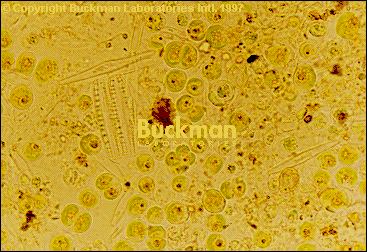 |
|
|
 |
|
 |
|
|
Algae are photosynthetic organisms that exist throughout the habitats of the earth, including the oceans, fresh water environments, and all dry land environments. They can survive in snow and ice, or hot boiling springs. Algae range in size from very small single cell organisms, to very complex multi-cellular forms. Most of the multi-cellular species are found in the oceans in the form of kelp and seaweed. Fossil records of algae date back over three billion years. Their reproduction varies from simple asexual cell division, to complex plant-like forms of reproduction. Algae are an important factor to all life, as they are involved as producers of organic matter at the very foundation of the life-cycle food chain. As all living things, algae require bacteria and enzymes for their survival. In the water environment, algae provide necessary oxygen for other aquatic life by means of photosynthesis. There are thousands of species of algae that have been identified. These have been grouped into eight general classifications, listed below. Bacillariophyta (diatoms) Unicellular organisms that are important component of phytoplankton living mostly in marine and fresh water environments. Charophyta (stoneworts) Fresh water plants that grow from the bottom substrate, anchored by rhizoids. Chlorophyta Predominately aquatic, green algae that varies in size. It stores starch (green alga) as a food reserve. Some species live in soils symbiotically with protozoa and fungi. Over 8,000 species. Chrysophyta (golden algae)
Photosynthetic unicellular organisms abundant in fresh water and marine habitats. Cyanobacteria (blue-green algae) This algae is scientifically classified as a bacteria because it lacks a membrane bonding nucleus, however it is photosynthetic and is included in the listings of algae. The blue-green algae was instrumental in increasing the level of free oxygen in the atmosphere of the earth billions of years ago. Blue-green algae are common in soils and waters and can survive extreme temperatures. Some can fix nitrogen as well as photosynthesize providing the mechanism for releasing free oxygen. Often occur symbiotically with protozoa, and lichen-forming fungi. Phaeophyta (brown algae) The brown algae has thousands of species, almost entirely of which are aquatic, and most of which live in cold water. They vary in size, but in most cases, they form into sea weeds in large underwater forests that provide habitat for many other organisms. Dinophyta (dinoflagellates) Dinoflagellates are free-swimming species of unicellular algae that share features common to both plants and animals. While carrying a reputation as harmful in nature (red tide), they carry out an important role as members of phytoplankton in marine and fresh water ecosystems. Rhodophyta (red algae) Red algae has over 6000 species, most which are marine, and few occur in fresh water. They are usually multi-cellular and are found attached to rocks, or to other algae. They are used widely in the food and pharmaceutical industries.
|
| [Welcome] [ViTech Home] [About Vitech] [Site Map] [Soil Building] [Plant Nutrition] [About Nutrients] [Soil Blends] [Foliar Blends] [Elemental Products] [Inquiries & Links] [Reference Data] |
|
